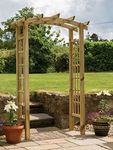Buying Guide for the Best Garden Arches
Choosing the right garden arch can transform your outdoor space, adding both aesthetic appeal and functional benefits. A garden arch can serve as a focal point, a support for climbing plants, or a charming entrance to different areas of your garden. When selecting a garden arch, consider the style and theme of your garden, the materials that will best suit your environment, and the size that will fit your space. Understanding the key specifications will help you make an informed decision that enhances your garden's beauty and utility.MaterialThe material of a garden arch is crucial as it affects durability, maintenance, and appearance. Common materials include metal, wood, and plastic. Metal arches, such as those made from wrought iron or steel, are sturdy and can support heavy climbing plants, but they may require rust protection. Wooden arches offer a natural look and blend well with garden settings, but they need regular treatment to prevent rot. Plastic arches are lightweight and low-maintenance but may not be as strong or durable. Choose a material that complements your garden's style and consider the climate and maintenance you are willing to undertake.
SizeThe size of the garden arch is important for both aesthetic and practical reasons. It should be proportionate to the space and the plants you intend to grow on it. Arches come in various heights and widths; a taller arch can create a grand entrance, while a wider arch can accommodate more plants or a pathway. Consider the space where you plan to place the arch and ensure it fits comfortably without overwhelming the area. If you plan to grow climbing plants, ensure the arch is tall and wide enough to support their growth.
DesignThe design of a garden arch can significantly impact the overall look of your garden. Designs range from simple and modern to ornate and traditional. A simple design might suit a contemporary garden, while an ornate design could complement a classic or cottage-style garden. Consider the existing elements in your garden and choose a design that harmonizes with them. The design should also be functional, providing adequate support for any climbing plants you wish to grow.
InstallationInstallation is an important consideration, especially if you plan to set up the arch yourself. Some arches are easy to assemble and come with clear instructions, while others may require more complex installation or professional help. Consider your DIY skills and the tools you have available. If you prefer a hassle-free setup, look for arches that are easy to install and come with all necessary hardware. Ensure the arch is stable and secure once installed, especially if it will support heavy plants.
MaintenanceMaintenance requirements can vary depending on the material and design of the garden arch. Metal arches may need regular rust treatment, while wooden arches might require sealing or staining to protect against weather damage. Plastic arches generally require less maintenance but should be checked for stability over time. Consider how much time and effort you are willing to invest in maintaining the arch. If you prefer low-maintenance options, choose materials and finishes that are durable and weather-resistant.

















